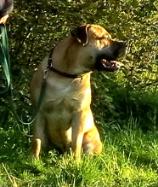
This is a placeholder text
Group text
by Ziva on 05 February 2022 - 15:02
by dogsportman357 on 05 February 2022 - 21:02
by Hundmutter on 06 February 2022 - 04:02
Ziva, in 50-odd years with the breed, I can tell you I have seen many cases of ears still playing "up / down" at 6 months, with those pups having them both properly up at 8 or 9 months without any human interference.
I have also seen many dogs with 1 or both ears still down by then, or later, even though people had struggled with the whole range of methods to try to help them stand.
Once in a blue moon, a dog which has had such help will stand them properly. But we have always asked ourselves whether that is because we interfered, or would it have happened anyway ?
If, once a dog's adult teeth have fully settled, that dog's ear (or ears) still flop over, to whatever degree, whether you have tried propping them up or not, then the cause is genetic. And then you just have to accept it.
There are no guarantees.
by Sunsilver on 06 February 2022 - 11:02
by Diamondgal on 06 February 2022 - 11:02
by Q Man on 06 February 2022 - 16:02
I have Working Line GSD's and ALWAYS begin feeding RAW Chicken with bones when young (a little at a time)...The bones will help exercise the jaws/ears then the bones are also a natural calcium source...
I have always massaged the bell of the ears as this will help promote blood flow...
But even doing all of these things in the end some ears just aren't going to stand but most of the time they do...
This is my way of helping with the ears and what I have found to work well...
~Bob~
by Rik on 06 February 2022 - 17:02
outside factors can be injury, too much time in a crate. certainly poor food choices could affect the ears but I don't think that's as large an issue as some.
I was involved in an activity that often saw weak ears and everyone panicked if they were slow coming up. 99.99% of the people I know would be putting them up by 6 months. the worst is if a crease develops at the base.
by GSCat on 07 February 2022 - 03:02
by Hundmutter on 07 February 2022 - 04:02
LOL Cat !!
Ziva, all these guys are far from new to GSDs; they are telling it like it is. To go back to your OP, I had not even heard of using Gelatin as 'a dog in the race'. Whoever suggested it to you, what did they say about the way it was supposed to work ?
I mean, (even when I don't set much store by them), raw / bones & encouraging chewing - I can understand; massage - I can understand; calcium - I can understand (but you have to set against that the dangers to bones' formation of excess calcium); and the physical methods using cut forms, glue, insets, and so on, I can understand.
But Gelatin ???
Have just remembered this:
When I was a kid I used to walk the 'guard dogs' for a local hauliers. In their yard, half the floor was, for months & months, taken up by a huge mound of part-processed gelatin. The dogs had access, and used to swallow bits of it when picking out balls etc thrown for them. While I was around, this pair produced 3 large litters. Some of those pups grew up where I could sometimes see them; a couple turned out to have drop ears or one ear down, for life. Neither parent did; but the sire had a brother with a wonky ear.
In case anybody reading this is inspired to make gelatin the next 'best thing' for ear-righting in Sheps, can I ask that people think about which factor - from gelatin or genetics - had the most influence in that case ?
by Mike Delaney on 07 February 2022 - 15:02
Another thing that at least SEEMS to help is to socialize-especially where there are lots of sights and sounds the pup may not have experienced. I like to take a pup on SHORT hikes in the woods. I let them run loose where they can spook squirrels, rabbits, lizards and such. The new experiences really get the ears moving around.
But-all the help in the world won't fix genetics. As someone said above-if the ears go up with my slight assistance they were probably going up anyway.
Mike
Contact information Disclaimer Privacy Statement Copyright Information Terms of Service Cookie policy ↑ Back to top




